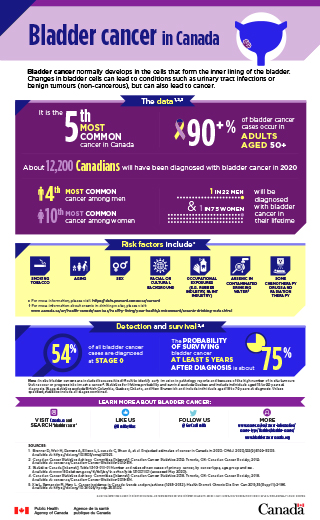Bladder cancer in Canada
Tell us what you think
Help us improve our products, answer our quick survey.

Download in PDF format
(PDF format,113.4 KB, 1 page)
Organization: Public Health Agency of Canada
Date Published: November 2020
Bladder cancer normally develops in the cells that form the inner lining of the bladder. Changes in bladder cells can lead to conditions such as urinary tract infections or benign tumours (non-cancerous), but can also lead to cancer.
The dataFootnote 1,Footnote 2,Footnote 3
- Bladder cancer is the 5th most common cancer in Canada
- It is the 4th most common cancer among men and the 10th most common cancer among women
- 1 in 22 men will be diagnosed with bladder cancer in their lifetime
- 1 in 75 women will be diagnosed with bladder cancer in their lifetime
- About 12,200 Canadians will have been diagnosed with bladder cancer in 2020
- More than 90% of bladder cancer cases occur in adults aged 50+
Risk factors includeFootnote a
- Smoking tobacco
- Aging
- Sex
- Racial or cultural background
- Occupational exposures (e.g. rubber industry, paint industry)
- Arsenic in contaminated drinking waterFootnote b
- Some chemotherapy drugs and radiation therapy
Detection and survivalFootnote 2,Footnote 4
- 54% of bladder cancer cases are diagnosed at Stage 0
- The probability of surviving bladder cancer at least five years after diagnosis is about 75% in Canada
Notes:
In situ bladder cancers are included because it is difficult to identify early invasion in pathology reports and because of the high number of in situ tumours that reoccur or progress into invasive cancerFootnote 5.
Statistics for lifetime probability, age and survival exclude Quebec and include individuals aged 15 to 99 years at diagnosis. Stage statistics exclude British Columbia, Quebec, Ontario, and New Brunswick and include individuals aged 18 to 79 years at diagnosis. Unless specified, statistics include all stages combined.
Learn more about bladder cancer:
Footnotes:
- Footnote a
-
For more information, please visit: https://data.prevent.cancer.ca/current
- Footnote b
-
For more information about arsenic in drinking water, please visit: https://www.canada.ca/en/health-canada/services/healthy-living/your-health/environment/arsenic-drinking-water.html
Sources:
- Footnote 1
-
Brenner D, Weir H, Demers A, Ellison L, Louzado C, Shaw A, et al. Projected estimates of cancer in Canada in 2020. CMAJ. 2020;192(9):E199–E205. Available at: https://doi.org/10.1503/cmaj.191292.
- Footnote 2
-
Canadian Cancer Statistics Advisory Committee [Internet]. Canadian Cancer Statistics 2019. Toronto, ON: Canadian Cancer Society; 2019. Available at: cancer.ca/Canadian-Cancer-Statistics-2019-EN.
- Footnote 3
-
Statistics Canada [Internet]. Table 13-10-0111-01 Number and rates of new cases of primary cancer, by cancer type, age group and sex. Available at: https://www150.statcan.gc.ca/t1/tbl1/en/tv.action?pid=1310011101 (accessed May 2020).
- Footnote 4
-
Canadian Cancer Statistics Advisory Committee [Internet]. Canadian Cancer Statistics 2018. Toronto, ON: Canadian Cancer Society; 2018. Available at: cancer.ca/Canadian-Cancer-Statistics-2018-EN
- Footnote 5
-
Xie L, Semenciw R, Mery L. Cancer incidence in Canada: trends and projections (1983-2032). Health Promot Chronic Dis Prev Can 2015;35(Suppl 1):2–186. Available at: https://doi.org/10.24095/hpcdp.35.S1.02.
© Her Majesty the Queen in Right of Canada, as represented by the Minister of Health, 2020 | Cat.: HP35-140/2020E-PDF | ISBN: 978-0-660-35799-7 | Pub.: 200159